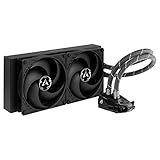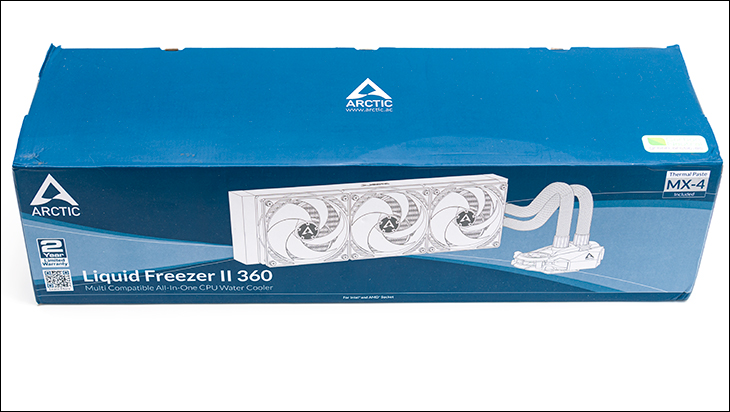
Arctic obviously spent a lot of time and effort on their marketing and it shows. Even on just a quick glance you will know this is an Arctic product. It looks, feels… and even acts like one. This is a good thing. The color scheme is attractive yet not garish – this large box will grab your attention without risking seizures in epileptics. Then once it has gotten your attention the combination of a veritable ton of pictures, details, descriptions, etc. will let you know precisely what the Liquid Freezer II 360 has to offer. This really is nearly everything we like to see in a shipping container and the Asetek ODM using competition really could learn a thing or two from it.
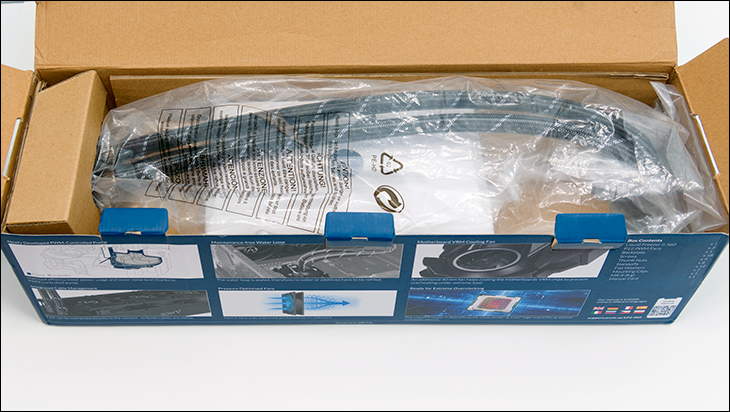
Internally Arctic is using a combination of copious amount of cardboard with intelligent packaging to ensure your Liquid Freezer II 360 arrives safe and sound. The end result is a shipping container that we would feel entirely comfortable with shipping across the country or even around the world.
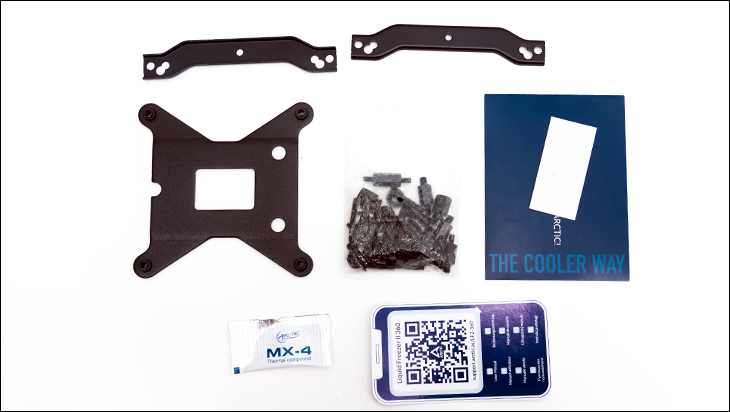
Moving on. The accessory list is not perfect, bit everything included is of the highest quality. For example, even though the waterblock and pump combo is not all that heavy an item the mounting backplate Arctic includes is a solid chunk of metal. Forget about flexing, or stripping out a post because the backplate is plastic (or worse still made from “number one best quality” Chinesium ‘steel’) this backplate is robust. It is of such high quality we are disappointed that it is for Intel 115x systems only. We really wish Arctic had included one for AMD instead of relying upon AMD motherboards integrated CPU backplate. Yes, saying we would rather have extra steps to deal with rather than using stock backplates just underscores the level of quality Intel users will have access to.
As to specifics, in grand total you can expect to find a big bag of screws for mounting the Liquid Freezer II 360 to everything from Intel 115x on up (with the exception of 1366 socket), and AMD AM4 (as long as your AMD motherboard comes with a backplate) compatibility. You will get a nifty ‘one shot’ packet of Arctic MX-4 TIM. You will even get an actually good and useful installation pamphlet. The only missteps is we wish the MX-4 TIM was a multi-use tube of MX-4… as this is TIM you will actually want to use on future builds. That and the fact that you will not be given extra screws to mount an additional three fans to the radiator. Given the low asking price we are not surprised to see Arctic… ‘round’ this corner, but what they do include is easily better and higher quality than the vast majority of AIO’s for sale right now – for Intel buyers. In the installation section we will go over how Arctic may have rounded a few too many corners for AMD buyers.
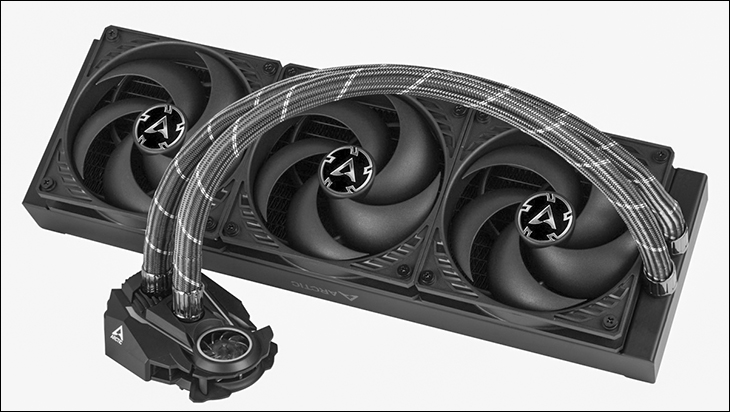
On the plus side, and as you will discover the moment you take the Liquid Freezer II 360 out of the shipping container, the three fans are already mounted to the radiator for you. This will save you a couple moments of effort during the installation stage and we always like to see companies go this extra mile for their owners. Also on the positive side, these fans are not your typical ‘stock’ fans. Rather, they are Arctic’s very own P12 PWM 120mm fans. Fans which have been optimized for high static pressure, low noise, and (thanks to Fluid Dynamic Bearings) longevity. These P12s retail for about $8 each and are worth every penny and then some. They actually are one of our favorite high static pressure fan models, as they not only come with ten-year warranties, they have an extremely wide operating speed range of 200 to 1800 rpms. They also move a decent amount of air (53.6 CFM) and do so with an impressive 2.2mm H20 static pressure rating. Compare and contrast these fans with say Noctua and you have to move up to Noctua’s A12 line to find better (be it static pressure, CFM, etc). A fan which will set you back a lot, lot more than 8 bucks. Basically, these are three fans you will not be in any hurry to replace to say the least. This is typically one of the areas AIO manufactures cut corners on to help reduce MSRP… and it is impressive to see Arctic not even ‘round’ this corner.
To be honest, the fans were not the first thing we noticed when we took the Liquid Freezer II 360 out of the box the first time. What we noticed was the incredibly attractive braiding they are using on their tubing. Yes, this is a minor thing in the grand scheme of things but this is easily the best, most attractive braided covering we have seen on any AIO… ever. To us it gives the tubing an Eastern Kingsnake look to the tubes, but most likely Arctic was going for some European Sea Snake motif. Either way, it is simply in a different league compared to the ‘basic black’ braiding most AIO’s – at best – come with.
No matter what it reminds you of, the color scheme will not only fit into a wide range of custom builds… it will enhance it. Gray (instead of basic black) combined with white striping really will give most builds an air of elegance that too few AIOs can give. This is why most AIO manufactures (especially Asetek based models) have to rely on a “LEDS EVERYWHERE!!!!1111” approach. Thankfully Arctic did not feel the need to include any LEDs. The downside is if you really need an AIO that lights up it will not be right for you. It however is pretty much tailor made for us – as we dislike generic LED lighting and feel that if a build requires lighting, we will do it via custom LED strips in strategic locations. This is bucking the trend of the industry and proves Arctic is not afraid to go their own way and blaze their own trail. Hopefully a trail that others will follow.

The reason we keep comparing and contrasting the Liquid Freezer II 360 with Asetek is simple. Regardless of what label is on the box Asetek is the ODM for the majority of AIOs on the market. Asetek is not the ODM for the Liquid Freezer II 360. This is an Arctic design not an Asetek one. As such it does not have the typical ‘Asetek quirks’. Quirks such as pumps that fail earlier than they should. Pumps that (relatively) eat way too much power for what they offer. Quirks like not integrating the fan’s cables and instead have a rat’s nest of cables to contend with. The Liquid Freezer II 360 has none of these quirks.
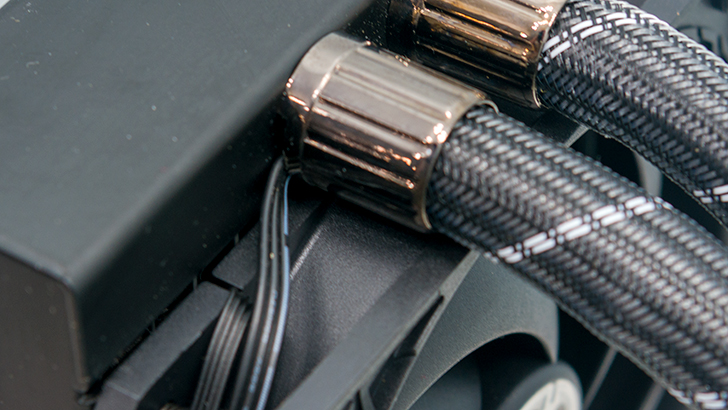
Let’s start with the cables. Usually three fan, 360mm AIOS mean dealing with tidying up three fan 4-pin cables, a 3 or 4-pin pump cable, and maybe even a USB cable. The Liquid Freezer II 360 has a grand total of one cable to contend with. This is because the Liquid Freezer II 360 not only comes with an integrated fan controller, and comes with the cables hidden underneath the oh so sweet braiding… it integrates the four fans as well as the water pump via your motherboards CPU header. Simply set up a ‘fan speed’ profile for this device in your mobo’s BIOS and it will take care of balancing water pump vs cooling fan(s) speed for you. All without needing to install and configure a dedicated software application. That certainly is ‘user-friendly’ in a nutshell.
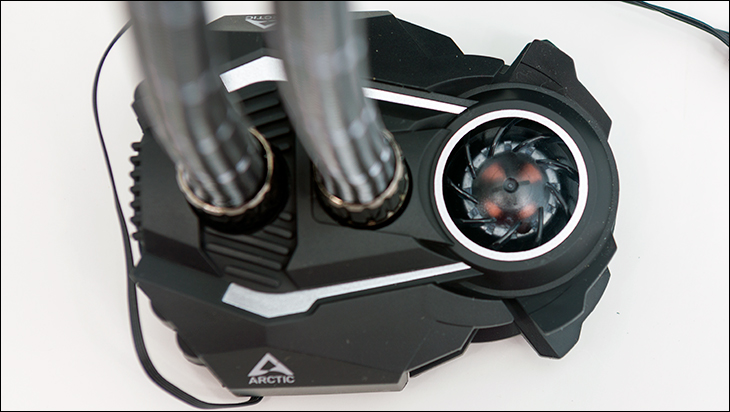
You may notice we keep talking about four fans. That is because the next feature of the Liquid Freezer II 360 is its integrated VRM cooling fan. Yes, Arctic really knows what enthusiasts really need… and gives it to them. This small 40mm fan may not move all that air (even at 3K rpm… it still is only a 40mm fan) but that couple CFM of air movement is down low and directed right at your motherboard’s VRM heatsinks. Heck, even motherboards without VRM heatsinks will notice a difference in VRM temperatures as this airflow is focused and will push air over ‘naked’ VRMs nicely.
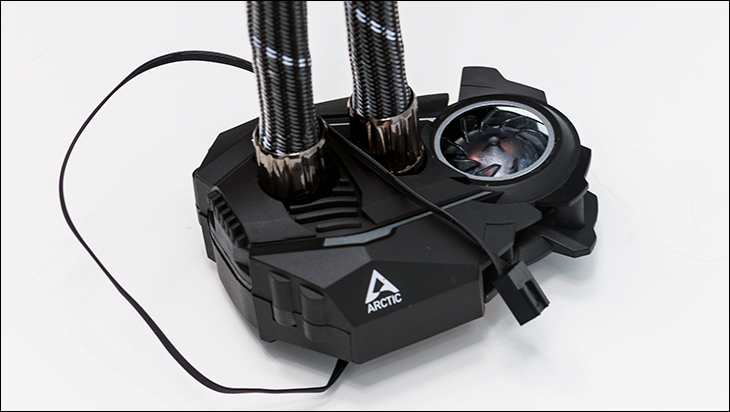
The only hesitation some system builders may have when hearing about this somewhat unique feature (e.g. ASUS’s RoG Ryujin has such a feature) is some variation on ‘what kind of amperage will you need to run all that?!’. The answer is… not as much as you would think. The gen 2 water pump Arctic has created uses very little power. How little? That is hard to state as Arctic’s specs not only include it but the 40mm fan in its “1 to 2.7” watts of power usage rating. On startup both slowly spin up to speed and are usually only going to suck down a single watt of power. Worst case though, 2.7 watts at 12v is 0.225 of an amp. The three P12 PWM fans only use a nominal max total of 0.24A (or basically a watt each) and they too will not start out at full tilt boogie. This intelligent lowering of startup draw means that the ‘startup surge’ really is not a surge at all. Put in simplistic terms, even a cheesy 0.5amp header should be able to handle this device, and any 1A header will be happy running the Liquid Freezer II 360. Yes, this massive cooler veritably sips power. That is the upside to not having a USB integrated controller, or integrated LED controller… and no LCD panels to have to power via ‘fan’ headers.
Next up. Instead of the typical 3/8th or 7/16ths OD tubing the Liquid Freezer II 360 uses 12.4mm (or basically 31/64 in hamburger units) Outer Diameter neoprene tubing. This increase allows the actually important (and yet rarely stated) internal diameter to be larger. Specifically, it is 6mm (or a hair over 5/16ths in hamburger units) ID tubing. ‘Wider’ not only carries more water per linear foot (in the Liquid Freezer II 360 the tubing is 450mm or 17.72 inches long) it can do so with lower static pressure. Basically, a wider tube is easier on the pump when dealing with the same amount of fluid being moved in the same amount of time.

The next change from the same old same old Asetek design is the radiator. Typically, Asetek based models use ~27mm thick radiators (and one easy way to spot most Asetek models). The upside to a thin rad is that it makes for an easier install with few(er) case compatibility issues. The downside… lowered performance. The whole point of large 360mm radiators is performance. Anything which negatively impacts this critically important feature is a bad thing. Arctic obviously grasped this simple, and yet seemingly difficult, idea. Instead of doing a thin but long rad, the Liquid Freezer II 360 comes with a long ‘360mm’ (actually more like 398mm) radiator that is 38mm thick. That is an increase of over 40.7percent. An increase which means a relatively greater quantity of coolant is housed in the Liquid Freezer II 360’s rad compared to similar Asetek based 360mm AIOs.
More importantly, this increased thickness means not only taller water channels (which decreases static pressure on the water pump) but it means room for wider aluminum cooling fins with more contact points for said fins. Bigger fins with more surface area, means more cooling performance. So not only can the Liquid Freezer II 360 carry more water (and thus take longer before water temperatures increase) it can keep its coolant… cool longer and easier. Put simply, this radiator is going to be much more effective and efficient and dumping heat from the CPU into the air than 27mm Asetek rads.
Somewhat counterbalancing these innovative ideas is a few minor nits worth picking. The first is… there is no easy way to keep such a clean looking setup if you do opt for six fans. You cannot, and really should not, daisy chain an additional three fans on to the existing four fans. Instead you will have to hide the wires like on any AIO build. Arctic really should think about making enthusiasts lives easier in this regard… even if it means two cables coming from the waterblock instead of just one. This really is a unit that cries out for six fans as it is a cooling unit that is built for insane levels of performance.
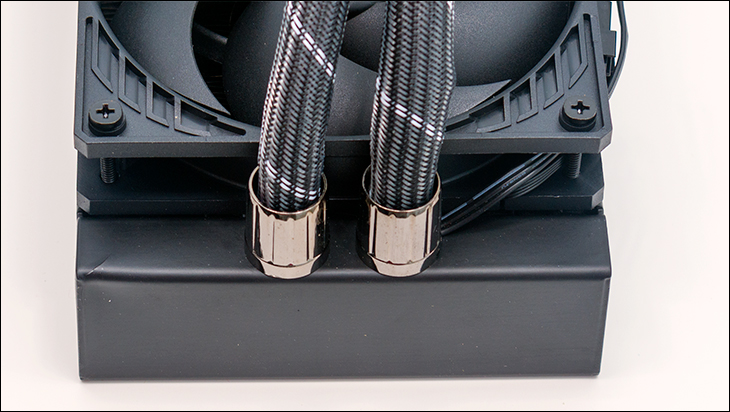
The other big nit is the tubing connectors. First and foremost is they are not swivel type connectors such as Asetek and most other ODMs use these days. Instead they are the ‘old school’ compression fittings which do not budge. This rigidity will make working with the tubes during installation more difficult as you will be fighting the tubes every step of the way. Since the waterblock connectors also do not swivel laterally / ‘side to side’ the end result is after installation will have more stress on the fittings as well.
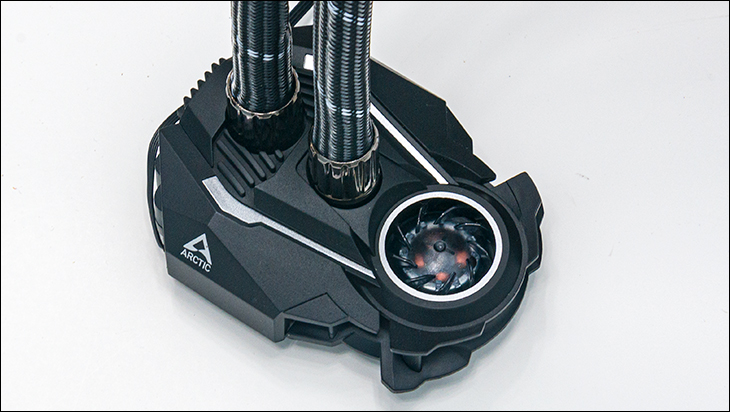
Next is the size of the waterblock. Most AIOs have downright petite blocks. The Liquid Freezer II 360’s waterblock is many things… petite is not one of them. It is 78mm wide by 98mm long by a reasonably 53mm tall. So, if you are looking for a ‘minimalistic’ look the Liquid Freezer II 360 probably will not be the right model for you. For most though, the downside to the waterblock is its overuse of plastic. Yes, it will (probably) remind you of a racing car, but funky styling or not that is whole lot of black plastic. Move the VRM fan to the top, the inlet/outlet headers to the side, make it rectangular… and please call it a day Arctic. This overly stylistic block does not add to the maturity of the design. It does the opposite as if the design team was trying way too hard to appeal to the PC Gaming crowd.
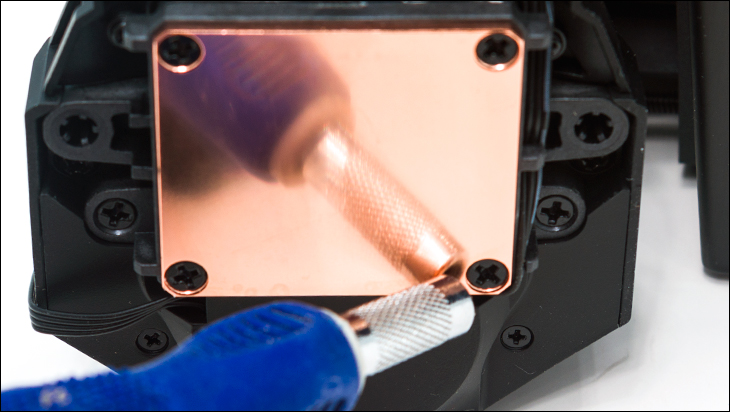
Lastly, if there was ever an AIO that cried out for upgradability… this is it. These old school fittings mean that you cannot easily pop one off and add in a secondary run to say your water-cooled GPU. Nor will you be able to add in a ‘water’ reservoir… or even flush, change, and burp the fluid every couple years. Arctic has a great foundation for a great modular water loop foundation with this design. One that could take on the likes of AlphaCool and their modular Eisbaer models. As it stands it is a great sealed closed loop cooling solution, but where a great opportunity for even more was missed. All for the sake of a couple quick disconnectors.



